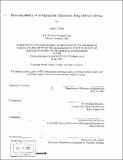Biocompatibility of an implantable ophthalmic drug delivery device
Author(s)
Cohen, Sarah J. (Sarah Jennifer)
DownloadFull printable version (12.50Mb)
Other Contributors
Massachusetts Institute of Technology. Dept. of Mechanical Engineering.
Advisor
Jonathan Bernstein and Simona Socrate.
Terms of use
Metadata
Show full item recordAbstract
Diseases of the posterior eye present clinicians with a treatment challenge mainly due to the region's inaccessible location. Several drugs, including those available for the treatment of exudative age-related macular degeneration, are currently delivered by periodic injection into the eyeball. To avoid the risks and complications associated with this method, several implantable, timed release devices have been investigated to deliver these drugs directly to affected areas. Draper Laboratory and Massachusetts Eye and Ear Infirmary have proposed an implantable, fully programmable, mechanical device for long-term drug delivery to the eye wall. To investigate the biocompatibility of this solution, test devices containing gears or a ball bearing were designed to mimic elements of its moving parts, geometry and materials. Cell culture studies identified a polytetrafluoroethylene filter with 100m pores as a promising addition to seal devices from interaction with fibroblasts. Test devices with or without this membrane were implanted on the rabbit eye for 2 or 10 week periods. They were evaluated mechanically after implant, and surrounding tissues were inspected histologically. Gross observation revealed a significant amount of tissue formation around the devices, especially in the conjunctiva. (cont.) Devices had to be cut away from the eye surface, and there was a significant amount of tissue inside the gear devices. Notably less tissue surrounded and invaded the ball bearing devices. Histological evaluation identified the invading tissue as fibrotic at both time points, though significantly more was seen at longer implant times. Eye wall tissue was typically unharmed during implant, though an additional layer of fibrosis between the eye and the device was common. Mechanical testing of long-term gear devices after implant revealed a 1000 fold increase in torque required to turn the elements, but long-term ball bearing devices were significantly less affected (100 fold increase). Torque also increased in devices with membrane covers, due to similar fibrosis. However, in these implants, tissue was forced to enter through only the 0.002in. openings around the base of the devices. Biocompatibility for this device may best be achieved by minimizing the amount of relative micro motion allowed between the device and the eye and by sealing all openings with a porous polytetrafluoroethylene filter.
Description
Thesis (S.M.)--Massachusetts Institute of Technology, Dept. of Mechanical Engineering, 2007. Includes bibliographical references (p. 90-94).
Date issued
2007Department
Massachusetts Institute of Technology. Department of Mechanical EngineeringPublisher
Massachusetts Institute of Technology
Keywords
Mechanical Engineering.